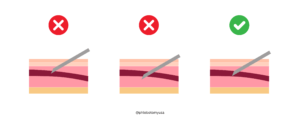27 Feb Bruising Prevention and Healing After a Blood Draw
Bruises are a familiar and often unavoidable consequence of various activities, injuries, or medical procedures like blood draws. While they are commonly experienced, they can be painful and unsightly. As such, preventing them is always preferable. Both phlebotomists and patients play an essential role in preventing bruising.
Understanding what bruises are, why they happen, and how to heal them is vital for minimizing discomfort and providing a positive experience during blood draws. In this article, we’ll explore why bruising happens, how to heal it, and, most importantly, how to avoid it.
What Are Bruises?
Bruises are also called hematomas. They happen when small blood vessels under the skin are damaged from injury or strain. This causes blood to leak into nearby tissues and lead to skin discoloration.
Bruises can range in color from red or purple to green, yellow, or brown as they heal. The size and color of a bruise depend on the injury’s severity and a person’s healing process. The body naturally reabsorbs the blood over time, which causes the bruise to fade. Healing can take a few days to a couple of weeks, depending on the bruise’s severity.
Why Do Bruises Happen?
Bruises after a blood draw can happen for several reasons, such as the needle’s impact, its size, and the skill of the person performing the procedure. How well you care for the area afterward and your overall health also plays a big role.
Not applying enough pressure or doing activities that strain the area can make bruising worse. Age, medication, and health conditions also affect bruising. Older adults bruise more easily due to thinner skin and fragile blood vessels, while blood thinners and anti-inflammatory drugs can increase bruising. Knowing these factors helps reduce bruising risk.
How Phlebotomists Can Prevent Bruising
Phlebotomists are the frontline warriors in preventing bruises. Here are some strategies to use to avoid hematoma formation:
- Choose a Vein Carefully: Choose a prominent vein that is accessible and stable. This reduces the likelihood of vein collapse or arterial puncture, which can lead to hematomas.
- Use the Right Equipment: A needle that is too large can cause too much damage to the vein, and a needle that is too small might not be effective. Both can increase the risk of a hematoma.
- Ensure Proper Positioning: The needle should fully enter the top wall of the vein but not pass through it. Not going deep enough or too far can cause tissue bleeding.
- Hold the Needle Still: Keep the needle steady once it’s placed. Moving it can scratch the vein walls and cause internal bleeding or a hematoma, especially when changing tubes.
- Release the Tourniquet First: Releasing the tourniquet before removing the needle reduces vein pressure, helping prevent hematomas. It’s best to release it once the blood flows steadily.

How Patients Can Prevent Bruising
Though phlebotomists conduct the draw, there are many things a patient can do to prevent bruising. Here are some tips to try:
- Wear Loose Clothing: Make sure you wear loose-fitting sleeves to your appointment to prevent constriction, which can exacerbate bruising.
- Apply Firm Pressure: After the needle is withdrawn, apply firm pressure to the site to help the vein clot and close. This helps minimize bleeding and reduces the risk of hematoma.
- Avoid Heavy Lifting: For several days post-draw, avoid engaging in heavy lifting or vigorous exercise that could strain the affected area and potentially cause or worsen a bruise.
- Choose Pain Relievers Wisely: If you require pain relief after the draw, opt for acetaminophen instead of aspirin or ibuprofen. This is because these can thin your blood and may increase bruising.
How To Heal a Bruise
Bruises sometimes happen despite our best efforts. They follow a natural process, changing from dark purple to green and yellow as the body reabsorbs the leaked blood. To help heal a bruise faster, you can apply a cold pack soon after the injury to reduce swelling and slow blood flow.
Later, use a warm compress to boost circulation and clear the blood more quickly. Keeping the area heightened can also help speed up healing. Topical treatments with arnica or vitamin K may help reduce discoloration and inflammation when applied to the bruise.
When to Seek Help
While most bruises are harmless and heal on their own, there are times when medical attention may be necessary. If you experience severe pain, swelling, or unusual symptoms around the bruise, don’t hesitate to seek medical advice.
In rare cases, bruising can be a sign of a more serious condition. For example, easy bruising may indicate a bleeding disorder or a deficiency in certain vitamins. If you notice frequent, large bruises without any apparent cause or if your bruises are accompanied by other symptoms such as nosebleeds or blood in your urine, it is important to consult a healthcare provider. They may perform tests to rule out underlying conditions that could be contributing to your bruising.
Managing Bruises in Special Populations
Some people are more likely to bruise easily and need extra care. Older adults often have thinner skin and fragile blood vessels, making them more prone to bruising. People taking blood thinners or medications that affect clotting are also at higher risk.
Extra precautions should be taken to prevent bruising, and any bruises should be closely watched. Those with chronic conditions like hemophilia or other bleeding disorders face additional challenges and should work with their healthcare providers. They can create a plan for preventing and managing bruises, including adjusting medications and using preventive measures during medical procedures.
The Psychological Impact of Bruising
While bruises are often considered a minor physical injury, they can have a psychological impact as well. Visible bruises can affect self-esteem and lead to feelings of self-consciousness. For some, the appearance of bruises may be a reminder of a traumatic experience, particularly if the bruise was caused by an accident or injury.
It’s important to address the emotional aspects of bruising, particularly in patients who may feel embarrassed or anxious about their appearance. Offering reassurance and providing practical advice on how to manage and conceal bruises can help alleviate some of these concerns. Encouraging open communication about how the patient feels can also be beneficial, as it allows for a more holistic approach to care.
The Role of Nutrition in Bruise Prevention and Healing
Nutrition is important for preventing and healing bruises. Certain vitamins and minerals help keep blood vessels strong and support healing. Vitamin C is needed for collagen production, which strengthens blood vessels and reduces the chance of bruising. A lack of vitamin C can weaken vessels and increase bruising.
Vitamin K helps with blood clotting and prevents excessive bleeding by sealing damaged blood vessels. Getting enough vitamin K from food or supplements can lower the risk of bruising.
Other nutrients like zinc and iron also aid healing. Zinc helps repair tissues, while iron supports red blood cell function. A balanced diet with fruits, vegetables, lean proteins, and whole grains can provide these nutrients to help prevent and heal bruises.
This guide is about providing a positive experience for both the patient and phlebotomist. At Phlebotomy Training Specialists, we understand that bruises are a common occurrence. With the right knowledge and preventive measures, their impact can be minimized. Our commitment to providing high-quality training for phlebotomists includes educating them on best practices for preventing and managing bruising.
We encourage patients to be proactive in their care, understanding their role in preventing bruises and knowing when to seek help if needed. By working together and following these tips and best practices, we can minimize discomfort and promote a safe and successful blood draw process. Here’s to a future where bruises are rare and comfort is common.

